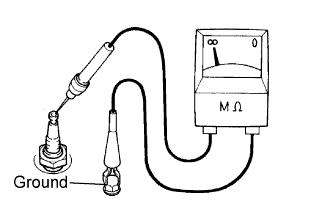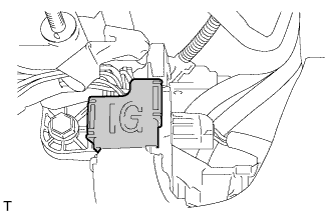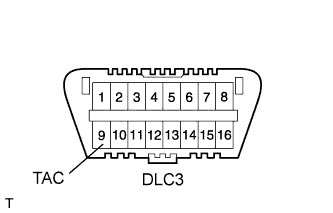Engine -- On-Vehicle Inspection |
| 1. INSPECT ENGINE COOLANT |
Inspect the engine coolant (COROLLA_ZRE142 RM000000V1Q0BYX_01_0003.html).
| 2. INSPECT ENGINE OIL |
Inspect the engine oil (COROLLA_ZRE142 RM000001R0T02BX_01_0002.html).
| 3. INSPECT BATTERY |
Inspect the battery (COROLLA_ZRE142 RM000001AR909TX.html).
| 4. INSPECT AIR CLEANER FILTER ELEMENT SUB-ASSEMBLY |
Remove the air cleaner cap sub-assembly (COROLLA_ZRE142 RM0000017UD05PX_01_0004.html).
Remove the air filter element.
Visually check that the air filter is not excessively damaged or oily.
If necessary, replace the air filter.
| 5. INSPECT SPARK PLUG |
- NOTICE:
- Do not use a wire brush for cleaning.
- Do not attempt to adjust the electrode gap of a used spark plug.
Check the electrode.
Using a megohmmeter, measure the insulation resistance.
- Standard Resistance:
- 10 MΩ or more
- HINT:
- If the result is not as specified, clean the spark plug with a spark plug cleaner and measure the resistance again.
 |
Alternative inspection method:
Quickly accelerate the engine to 4000 rpm 5 times.
Remove the spark plug.
Visually check the spark plug.
If the electrode is dry, the spark plug is functioning properly. If the electrode is damp, proceed to the next step.

Check the spark plug for any damage to its threads and insulator.
If there is any damage, replace the spark plug.- Recommended Spark Plug:
Manufacturer Product DENSO SK20R11 NGK IFR6A11
Reference:
- Maximum Electrode Gap for Used Spark Plug:
Electrode Gap 1.3 mm (0.0512 in.)
- Electrode Gap for New Spark Plug:
Electrode Gap 1.0 to 1.1 mm (0.0394 to 0.0433 in.)
 |
Clean the spark plug.
If the electrode has traces of wet carbon, clean the electrode with a spark plug cleaner and then dry it.- Air pressure:
- 588 kPa (6 kgf/cm2, 85 psi)
- Duration:
- 20 seconds or less
- HINT:
- Only use the spark plug cleaner when the electrode is free of oil. If the electrode has traces of oil, use gasoline to clean off the oil before using the spark plug cleaner.
 |
| 6. INSPECT V-RIBBED BELT |
Check the belt for wear, cracks or other signs of damage.
If any of the following defects is found, replace the V-ribbed belt.- The belt is cracked.
- The belt is worn out to the extent that cords are exposed.
- The belt has chunks missing from the ribs.
- The belt is cracked.
 |
Check that the belt fits properly in the ribbed grooves.
- HINT:
- Check by hand to confirm that the belt has not slipped out of the groove on the bottom to the pulley. If it has slipped out, replace the V-ribbed belt. Install a new V-ribbed belt correctly.
 |
| 7. INSPECT IGNITION TIMING |
- NOTICE:
- Turn all the electrical systems and the A/C off.
- When checking the ignition timing, move the shift lever to neutral.
Warm up and stop the engine.
When using the Techstream:
Connect the Techstream to the DLC3.
Turn the ignition switch to ON.
Turn the Techstream on.
Enter the following menus: Power Train / Engine and ECT / Data List / IGN Advance
Start the engine.
According to the display on the Techstream, read the Data List.
- Standard ignition timing:
- 5 to 15° BTDC at idle
Check that the ignition timing advances immediately when the engine speed is increased.
Turn the ignition switch off.
Disconnect the Techstream from the DLC3.
When not using the Techstream:
Remove the No. 1 engine cover sub-assembly (COROLLA_ZRE142 RM000001BC301CX_01_0101.html).
Open the ignition cover located to the right of the No. 4 ignition coil.
Pull the wire harness out from the IG cover.
Connect the timing light to the wire harness.
- NOTICE:
- Use a timing light that detects the primary signal.
Using SST, connect terminals 13 (TC) and 4 (CG) of the DLC3.
- SST
- 09843-18040
Allow the engine to idle and check the ignition timing.
- Standard ignition timing:
- 8 to 12° BTDC at idle
- HINT:
- Run the engine at 1000 to 1300 rpm for 5 seconds, then check that the engine speed returns to idle speed.
Disconnect SST from terminals 13 (TC) and 4 (CG) of the DLC3.
Allow the engine to idle and check the ignition timing.
- Standard ignition timing:
- 5 to 15° BTDC at idle
Check that the ignition timing advances immediately when the engine speed is increased.
Turn the ignition switch off.
Remove the timing light.
Close the IG cover.
Install the No. 1 engine cover sub-assembly (COROLLA_ZRE142 RM000001BC101CX_01_0268.html).


| 8. INSPECT ENGINE IDLE SPEED |
- NOTICE:
- Turn all the electrical systems and the A/C off.
- When checking the idle speed, move the shift lever to P or neutral.
Warm up and stop the engine.
When using the Techstream:
Connect the Techstream to the DLC3.
Turn the ignition switch to ON.
Turn the Techstream on.
Enter the following menus: Power Train / Engine and ECT / Data List / Engine Speed
Start the engine.
According to the display on the Techstream, read the Data List.
- Standard idle speed:
- 600 to 700 rpm
Turn the ignition switch off.
Disconnect the Techstream from the DLC3.
When not using the Techstream:
Turn off all the accessories and air conditioning.
Move the shift lever to P or neutral.
Connect SST to 9 (TAC) of the DLC3 terminal, and then connect a tachometer to SST.
- SST
- 09843-18030
Start the engine.
Check the idle speed with the cooling fan off.
- Standard idle speed:
- 600 to 700 rpm
Turn the ignition switch off.
Remove the tachometer and disconnect SST from the DLC3.

| 9. INSPECT COMPRESSION |
Warm up and stop the engine.
Remove the 4 ignition coils and spark plugs (COROLLA_ZRE142 RM000001QVM03MX.html).
Disconnect the 4 fuel injector connectors.
Insert the compression gauge into the spark plug hole.
 |
Fully open the throttle.
While cranking the engine, measure the compression pressure.
- Standard compression pressure:
- 1300 kPa (13.3 kgf/cm2, 189 psi)
- Minimum compression pressure:
- 1000 kPa (10.0 kgf/cm2, 145 psi)
- Standard difference between each cylinder:
- 100 kPa (1.0 kgf/cm2, 15 psi) or less
- NOTICE:
- Always use a fully-charged battery to obtain an engine speed of 250 rpm or more.
- Check the other cylinders in the same way.
- This measurement must be done as quickly as possible.
- HINT:
- If adding oil increases the compression, the piston rings and/or cylinder bore may be worn or damaged.
- If pressure stays low, a valve may be stuck or seated improperly, or there may be leakage in the gasket.
Connect the 4 fuel injector connectors.
Install the 4 spark plugs and ignition coils (COROLLA_ZRE142 RM000001QVK03PX.html).
| 10. INSPECT CO/HC |
- HINT:
- This check determines whether or not the idle CO/HC complies with local regulations.
Start and warm up the engine.
Run the engine at 2500 rpm for approximately 180 seconds.
Insert the CO/HC meter testing probe at least 40 cm (1.3 ft.) into the tailpipe while idling.
Inspect the CO/HC concentration during idle at 2500 rpm.
If the CO/HC concentration does not comply with local regulations, troubleshoot in the order given below.Check the A/F sensor and heated oxygen sensor operation.
See the table below for possible causes, then inspect the applicable parts and repair them if necessary.
CO HC Problem Possible Cause Normal High Rough idle 1. Faulty ignition:
- Incorrect timing
- Plugs are contaminated, shorted, or gaps are defective
2. Incorrect valve clearance
3. Leaks in intake and exhaust valve
4. Leaks in cylindersLow High Rough idle
(Fluctuating HC reading)1. Vacuum leakage:
- Ventilation hoses
- Intake manifold
- Throttle body
- Brake booster line
2. Lean mixture causing misfireHigh High Rough idle
(Black smoke from exhaust)1. Restricted air filter
2. Plugged PCV valve
3. Faulty EFI system:
- Faulty pressure regulator
- Faulty engine coolant temperature sensor
- Faulty mass air flow meter
- Faulty ECM
- Faulty injectors
- Faulty throttle body